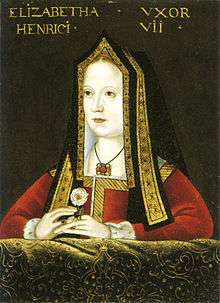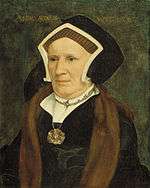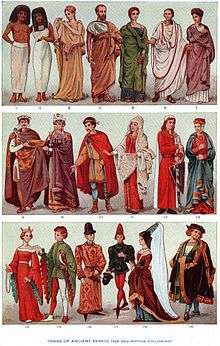Gable hood
A gable hood, English hood or gable headdress is an English woman's headdress of c. 1500–1550, so-called because its pointed shape resembles the gable of a house. The contemporary French hood was rounded in outline and unlike the gable hood, less conservative, displaying the front part of the hair.
Mary Wotton, Lady Guildenford, wearing a gable hood with pinned up lappets and a hanging veil. Hans Holbein the Younger, 1527.
Originally a simple pointed hood with decorated side panels called lappets and a veil at the back, over time the gable hood became a complex construction stiffened with buckram, with a box-shaped back and two tube-shaped hanging veils at 90-degree angles; the hanging veils and lappets could be pinned up in a variety of ways to make complex headdresses.
Gallery
 Early gable hood: Elizabeth of York c. 1500
Early gable hood: Elizabeth of York c. 1500 Front and back views of a box-backed gable hood of c. 1528–30. Detail of a drawing by Holbein
Front and back views of a box-backed gable hood of c. 1528–30. Detail of a drawing by Holbein Gable hood with lappets and one side of veil pinned up (engraving after Holbein c. 1535)
Gable hood with lappets and one side of veil pinned up (engraving after Holbein c. 1535) Gable hood of c. 1543
Gable hood of c. 1543
gollark: Oh, those are already using optical phased arrays to track photon count in an arbitrary number of discrete frequency buckets.
gollark: I mean, a Fourier transform would allow bees to incurse into the frequency domain instead of the time domain.
gollark: Alternatively, something something Fourier transform of inbound light signal?
gollark: If it was then... construct a polynomial through all those points?
gollark: I'm pretty sure it's not, though.
References
- Ashelford, Jane: The Art of Dress: Clothing and Society 1500–1914, Abrams, 1996. ISBN 0-8109-6317-5
- Ashelford, Jane: A Visual History of Costume: The Sixteenth Century, Drama Books, 1983. ISBN 0-89676-076-6
External links
| Wikimedia Commons has media related to Gable hood. |
This article is issued from Wikipedia. The text is licensed under Creative Commons - Attribution - Sharealike. Additional terms may apply for the media files.
